Northern KwaZulu-Natal is a place of big stories, and a big conservation idea has been brewing in Jozini that could make the area another of SA’s strongest drawcards. But will it happen? Photographs by Teagan Cunniffe.
We all have dreams. Most of us, though, dream small, focused on our own worlds. Going to Morocco or New York on holiday, say, or owning a little piece of heaven somewhere enviable. There are people that dream big, for their society or the world, such as Steve Biko, Mandela, Elon Musk, Ian Player the conservationist, for example, but they are rare, because a big dream is a heavy thing to carry. Then there are those who have dreams happen to them, who are, perhaps, designated. This is the case of Heinz Kohrs.
It’s 1968. It’s bedtime and the generators have just chugged to a halt. The night is heavy with darkness and heat and mosquitoes, as is usual in summer in this area we’ll call broader Jozini in northern KwaZulu-Natal. A small boy of German heritage wanders out to the stoep and climbs onto a riempie bed set outside for exactly such nights. The home is located below the Lebombo Mountains, on a stretch of land that will soon overlook the Pongolapoort Dam – it is being constructed. Perhaps it’s the heat that leads to fertile fantasies, but early that morning the boy wakes up, his imagination on fire from an enthralling dream: he was taking a drive with his father on the family ranch and there, miraculously, was a herd of elephant. In his dream, they came to the farm from a place high up in Africa.
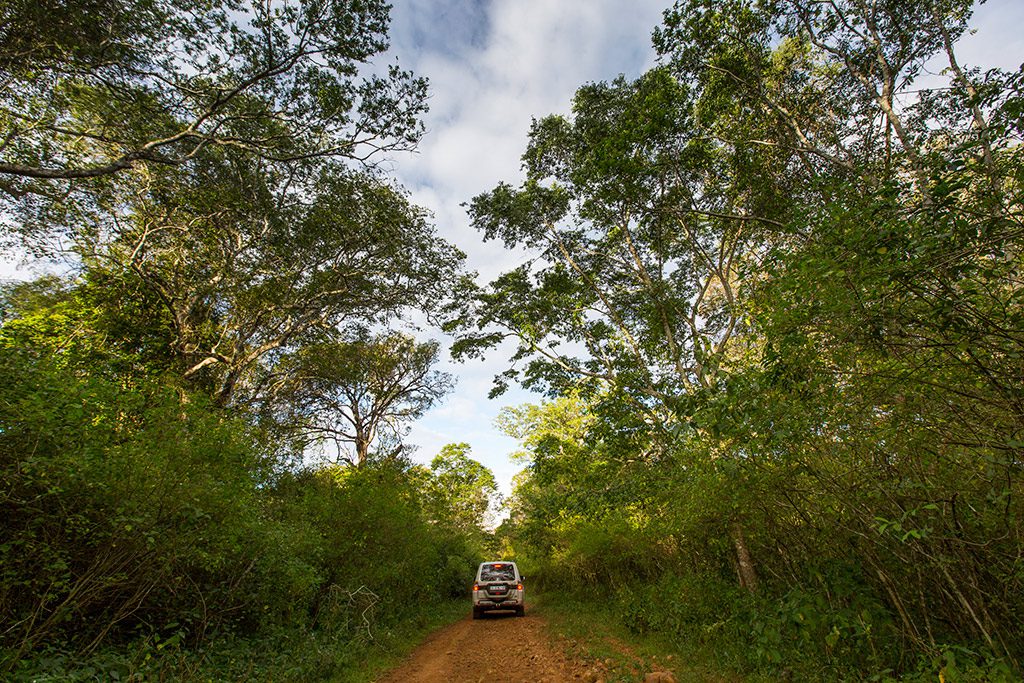
Roads near Hlatikulu Forests are tough and require a 4×4 like our Mitsubishi Pajero 3.2 GLS Auto LWB, which did us proud.
Awake now, it seems to him the dream is what’s real, and reality – the ranch without elephants – is the dream. It’s 2016, 48 years later. I’m standing at White Elephant Lodge, owned by the Kohrs family and Heinz, now a vet. This is close to where the dream occurred. I’m with my brother, Kilaan, and photographer Teagan Cunniffe. The lodge is set on a rise in the landscape, and from there we can see, laid out before us like a large, irregular silver carpet, the Pongolapoort Dam. Behind it are the Lebombo Mountains, the impressive basalt ridge that reaches up into the blue sky. To the left, the range heads into Swaziland, and in front of it, the dam extends a long sliver of an arm. There, in that thin sliver of water, is a sight that sets the heart aflame: a herd of elephant. The group begins in a line, gathers its numbers into a thick, snug centre, then thins out again towards the pioneering ellie wading up ahead. There must be sixty to seventy of them. Sounds like a neat story, doesn’t it: boy has dream, dream comes true? But real life is, of course, much more messy than that. Messy, though, is in keeping with this area.
This place has always felt dramatic to me. It’s where I grew up, close to the reserve we’re standing on. Historically it was a struggle living here; it was a malaria area, and many cotton and sugar cane dreams ended in tears. There was also plenty of politics: it was here, in these Lebombo Mountains, that Dingane kaSenzangakhona fled and was murdered, apparently erroneously, by the Nyawo tribe, descendants of whom still live in the area. His gravesite is in the Hlatikulu Forest, close by. In 1884, the final battle between Dinuzulu kaCetshwayo and Zibhebhu kaMaphitha played out here. The battle ended badly for Zibhebhu. The area is close to Mozambique and on the Swaziland border. During apartheid, in my youth, the army presence was strong here, and it’s rumoured that a derelict building close by was used as an interrogation centre during these years. It’s the first time I’ve heard this chilling story. There are also numerous land claims pending in the area.
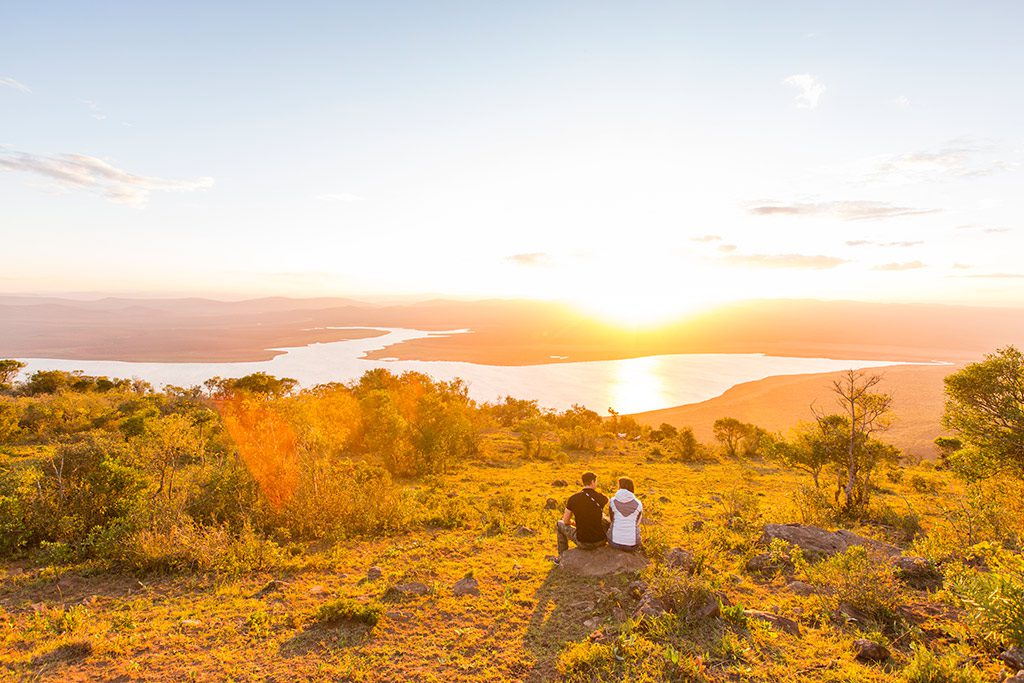
My brother, Kilaan, and I were returning to our childhood home to see how tourism has influenced it.
The history of wildlife here is equally brutal. In the early 1800s, the area below the Lebombo Mountains teemed with game. White hunters, with their greedy appetites, put an end to this abundance, so much so that in 1894 Paul Kruger declared an area the Phongolo Nature Reserve, the first of its kind in Africa (he had political motives, too, wanting to create a buffer). The core of this still exists today. Then in the early 1900s, wildlife was blamed for attracting Tsetse fly, the cause of sleeping sickness. It was open season for hunters, and the ensuing slaughter is mind boggling: in 1916, 25 000 wildebeest were shot; in 1939, 15 130 zebras; and in 1942, 138 529 wild creatures. Hunting in this area was well entrenched, and still is. The elephants that brought Heinz’s vision to life came from Kruger National Park, and were translocated as an alternative to culling, a story that was recorded by the BBC. You can watch this at the research centre of the farm, where guests can go ‘elephanting’ with monitor and researcher Heike Zitzer. It’s here I hear about the complexities of the situation.
This is my simplified interpretation: to move the elephants into the area meant more properties than just the Kohrs family ranch had to be brought on board. Amazingly, this was achieved, and seven farms dropped their fences to create the Pongola Game Reserve. But as time went on, different visions came into play, and an agreement had to be reached by vote. The seemingly simple plan of managing the herd’s numbers by vasectomising some bulls was frustrated. It was recommended that the area ideally could hold 35 elephants. By 2015, the herd reached the eighties, which has brought about an uneasy situation. The elephants are the reason I have come, as well as our trip down memory lane. I’m curious to see how the area has transformed.
With the ellies, this is one of the few places outside of Mana Pools where you can see a big herd from the water. It is, apparently, breathtaking. But just before we arrive, the herd wades across to Swaziland. Some people are excited – the elephants are doing something naturally that speaks to an even bolder idea that goes beyond Heinz’s dream, and that is creating a transfrontier park such as the one Kruger National Park is part of, the Great Limpopo Transfrontier Park.
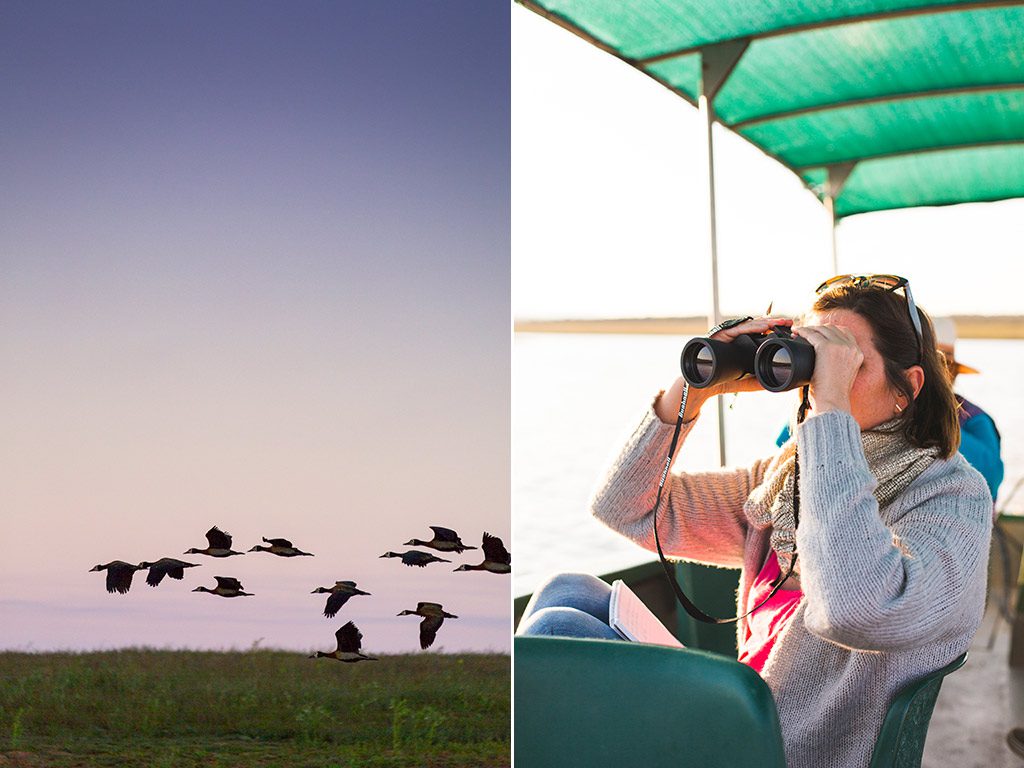
Sunset birdwatching on the dam with the Blevins.
The proposed Lubombo Transfrontier Conservation and Resource Area (Lubombo TFCA) would link iSimangaliso Wetland Park with a number of game reserves, private and traditional leaders’ lands. This would allow the ellies to move freely from iSimangaliso right through to Swaziland, but perhaps even eventually to Kruger and Mozambique. It would restore some of the natural migration routes interrupted by man via farming and fences and borders. Even more than that, it would – will – allow all animals to move freely, giving areas that are under strain a break, plus the blossoming of biodiversity. It would restore a natural order. It’s not hard to imagine the land beneath the Lebombo Mountains teeming with wildlife again, and the tourism that would bring to the area. Now this is a dream worth pushing!
The drought has been cruel to the area. We visit in June; it hasn’t rained in two summers and three winters. Mkhuze Game Reserve is bone dry, and the hippos of Nsumu Pan are relegated to a sad collection of muddy backs humped together into a tiny glutinous pool of mud – in a transfrontier park, they would have the opportunity to go seek water. Down on the Pongolapoort Dam, despite the water having receded, the hippos are happy.
We take two boat rides along the shore, one with White Elephant Safari Lodge in the morning, one with old familiars, the Blevins, who own the Shayamoya Tiger Fishing and Game Lodge and are avid bird watchers. On their boat we get the northern hospitality one finds readily in the area, gin and tonics, with the emphasis on the gin and banter. The shores teem with life: we see black-winged stilts, blacksmith lapwings, lesser flamingos, African open bills and spoonbills, Spurwing and Egyptian geese, grey herons, the sacred, glossy and hadedah ibis and a Goliath heron that scoops up a huge fish while being stalked by a crocodile. A guide tells us that a croc researcher concluded the dam has the fourth largest crocodile population in the world, a fact I can’t verify, but they’re indeed prolific.
I also see an African fish eagle in mid-call. I’m able to study the way it throws back its head, like a rooster, time after time. Later, we watch a pearl-spotted owlet’s comical gawk, and a white-backed vulture with her rock-star cowl rippling in the breeze. We pass a marabou stork in his undertaker’s suit, waiting patiently for death (ironically, his own; we later saw him laid out). Mammals may be struggling in the bush, but this is birding heaven. As a transfrontier park, couldn’t it be paradise?
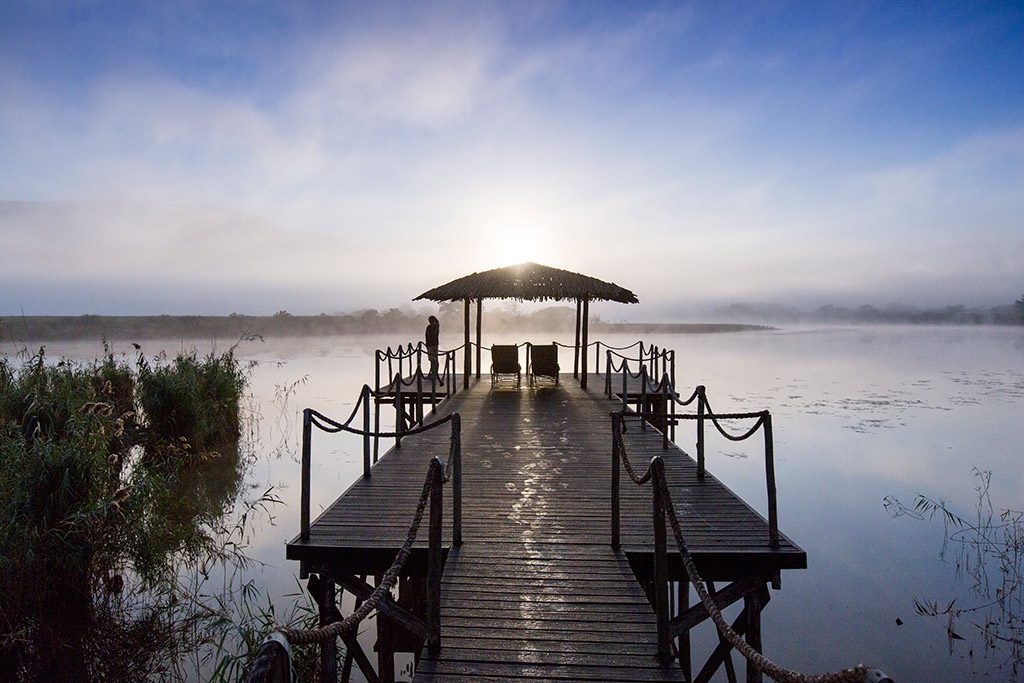
A chill spot at the Ghost Mountain Inn where you can watch wildlife, gin and tonic in hand.
There is no shortage of industry here. The Shayamanzi Houseboats, owned by Roger Blevin, offer the experience Zimbabwe’s Kariba is famous for. Hunting is still big, but eco-tourism is gaining traction. The Senekal family has opened Africa’s first exclusively photographic reserve, Zimanga Private Game Reserve. The vision of this as a tourism hotspot is not new. As far back as 2004 there was a development proposal put forward by the Department of Water Affairs and Forestry that had great visions for the area, with an emphasis on spreading the wealth to local communities. This seems to have dissipated, but community involvement is a big goal of Space for Elephants, which also aims to establish community run 4×4 and cycling routes.
It seems there are never simple answers for any region where a host of people need to make their livings off of it. But it’s no stretch to imagine how it could boom. There is experience after experience here we enjoy: the walk in the ancient fig forest in Mkhuze, led by Patrick Mathe (who turns out to be brother to the woman who cared for us as children, Nesta Mathe, which we discover when we visit her; she is now a traditional healer). We walk through massive trees alive with birdlife, while the grass dances with butterflies.
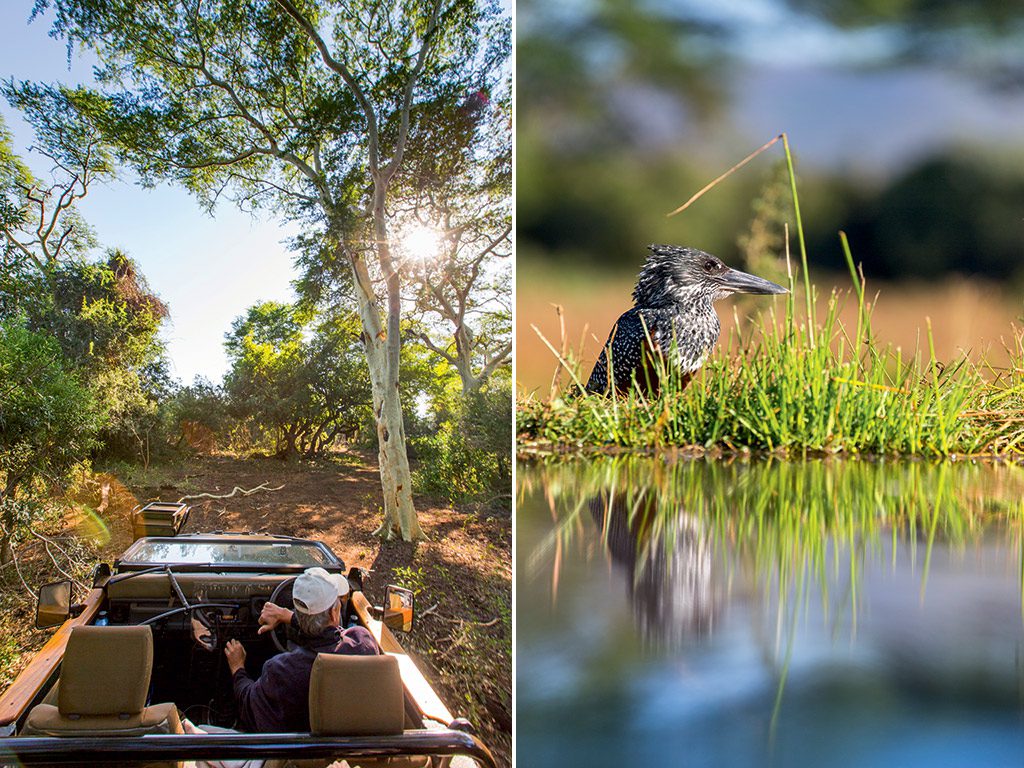
RIGHT: Zimanga, a farm converted to a game reserve, has sophisticated photo hides. LEFT: A giant kingfisher.
A few days later we drive through a run-down Jozini town – which has just had service delivery protests – to Hlatikulu Forest. The forest is wild up there, and thick and green and full of birdcalls. I’m dying to discover more, and my brother is aching to find Dingane’s grave, but dusk is falling and instead we drive back along the rough roads to take in the exquisite view high above the dam, which looks large and golden and full of possibility. Around us is a quiet, pastoral scene. Small houses with goats and chickens and dogs and more goats. There’s no lack of beauty in this area.
The folklore, when we were young, was that ghosts roam these mountains. The poor souls were warriors who were thrown off the cliffs. This is the source of the name of Ghost Mountain Inn, in tiny Mkuze town, where we book in. We visited here as children, and we’re thrilled to see it’s kept its heart, despite renovations. Craig Rutherfoord, second generation, now oversees the business.
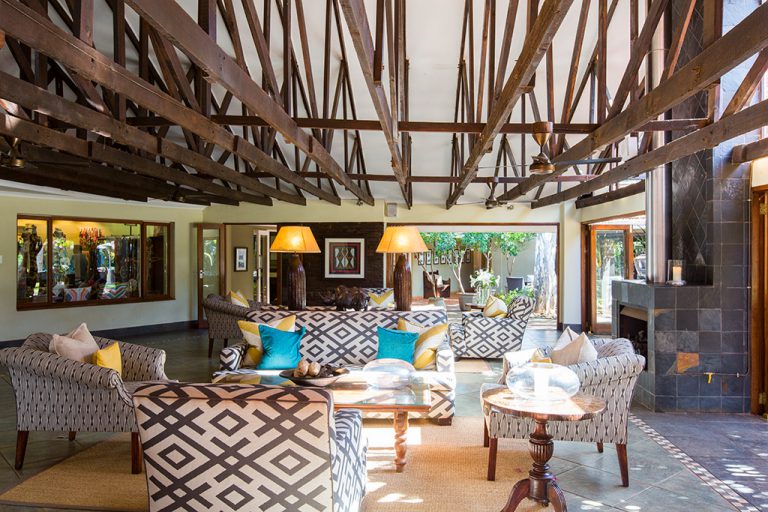
The lounge at Ghost Mountain Inn opens out onto the pool and garden.
‘Tourism was foreign here,’ he tells us over dinner, ‘but gradually, over the last 40 years, we’ve seen a huge change in the area.’ He believes the offering exists to draw more tourists.
‘You’ll always have to fight the Kruger and Cape Town brands, but what also helps us is people struggling to find accommodation there. It’s displaced business that’s coming to us… Ultimately, it would be great to drop all fences, from Lebombo all the way through to Mkhuze. To watch elephants from the boat is unique and in summer to see them swimming is phenomenal.’
However, there is lots standing in the way of this vision. It’s a perfect analogy for the age-old fight between wild spaces and humans. Who will win? History shows probably man, but I fervently hope perhaps this one time, this dream could win. What would that mean for this place of big stories? Now that would be another one for the history books. It’d be an exquisite Southern African success story. Complicated to achieve it, perhaps. But exquisite.
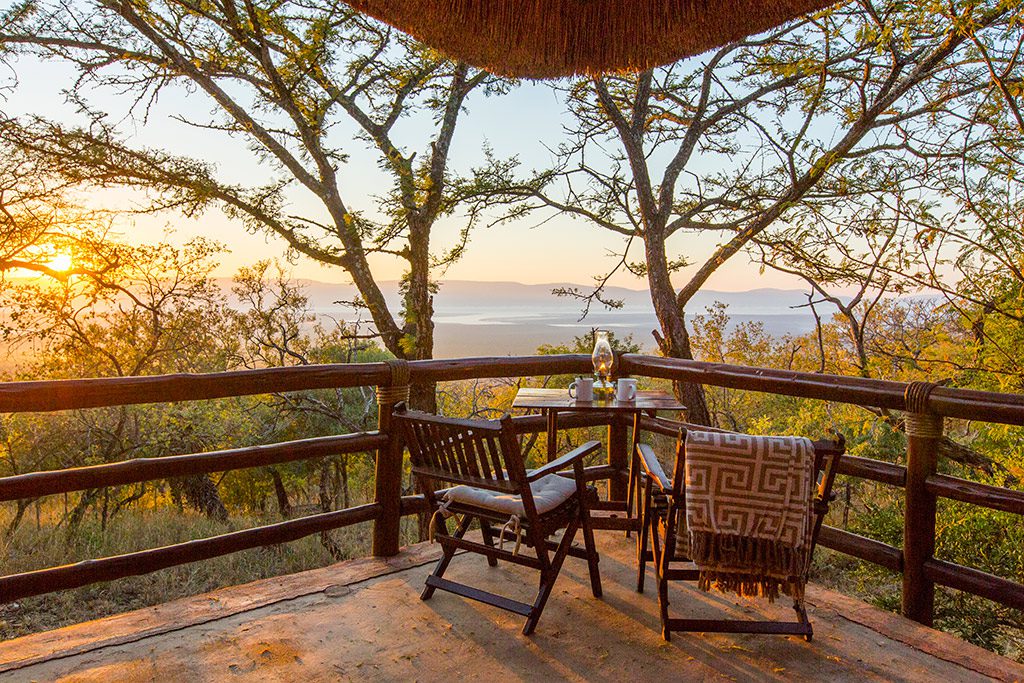
Sunset at Shayamoya Tiger Fishing and Game Lodge.
Jozini trip planner
Getting there
From King Shaka International Airport, take the N2 toll road to Richards Bay/Empangeni (you’ll pay R9,50, R11,50 and R39 on the way) past Hluhluwe to Mkhuze.
When to go
Spring is a good time for this area, as is autumn. Summers average temperatures of 35°C, while winters are mild.
Need to know
There are few mosquitoes, but take repellent as a precaution. Spraying it on your shoes and socks will keep ticks at bay for tick-bite fever. There are hunting concerns in the area, which I’ve stated where relevant.
Driving
We drove the Mitsubishi Pajero 3.2 GLS Auto LWB , and were grateful for it on the dirt roads. Although most places are reachable in a family sedan, getting to Hlatikulu Forest was challenging. We had to enter the forest down a rugged cattle track, and back out was over some very rocky terrain. The Pajero, with its low-range gear options, intelligent anti-slip technology and powerful diesel engine, made light work of it. Diesel usage was admirable, considering the length of the trip and range of terrain covered; over 2 000km we filled up three times only, at around R700 a pop. mitsubishi-sa.co.za ‒ Kilaan Schoeman
What to do in Jozini
Go elephanting with Heike Zitzer. It’s like walking in the footsteps of an elephant monitor. Cost from R400 per person (free when staying at WESL). whiteelephant.co.za
Visit Phongolo Nature Reserve and Mkhuze Game Reserve. Don’t miss the Fig Forest walk (R250 per person). Entry is R40 per adult, plus R5 per person daily levy per person, R30 for children, and R50 per vehicle. Phongolo is the oldest in the country, and has black rhino. Entry R50 per adult, R25 per child, R50 per vehicle. kznwildlife.com
Experience local life at the Mkuze Country Club. Wednesday is ladies’ night. 0355731441
Take your best wildlife shot at Zimanga Private Game Reserve’s hides. From R1275 per person (SADC rates). zimanga.com
Visit Hlatikulu Forest but do so with a trusted guide. Call Jean Toucher, Safari Manager at Ghost Mountain Inn to tailor make a tour for you. We used GMI guide Bheki Jobe on another tour; he’s an excellent birder. From R180 per person. ghostmountaininn.co.za
Fish with Shayamanzi Houseboats. We didn’t do it this time, but have before. Costs for groups of six or less start at R2450 per person sharing, minimum two nights. shayamanzi.co.za
Where to stay in Jozini
White Elephant Safari Lodge‘s main lodge, where you dine, is classic, with big leather couches and a deep stoep and pool. There are eight stylish luxury tents. There’s also a charming, self-catering Bush Camp for groups, and Umkhaya Cottage, perfect for a small family. Lodge prices start at R2 600 per person (includes two eco- activities and all meals); Bush Camp starts at R4320 per night (sleeps up to 16); Umkhaya starts at R2160 per night (sleeps four). Please note: management hunting takes place on Pongola Game Reserve; hunting is not allowed on WESL. whiteelephant.co.za
Ghost Mountain Inn is one of my favourite hotels in the country. It’s well priced and stylish, but unpretentious, the downfall of many a country hotel. It’s rooted in the Mkuze community. Plus it has a good dinner buffet at R250 (also try the imfino gnocchi on the à la carte menu). Prices from R820 per person sharing, B&B. ghostmountaininn.co.za
Shayamoya Tiger Fishing and Game Lodge is set on a ridge in an exceptional indigenous garden rich in birdlife. Its height gives it a spectacular view over the dam. The cabins are wooden and private, each with an outdoor shower. The Family Suite is a winner; in fact, this is a great place for families ‒ there’s a relaxed atmosphere, a pool and many activities. The restaurant and bar offer good fare, reasonably priced too. Prices from R750 per person sharing, B&B. Please note: there is a hunting camp on the property. shayamoya.co.za
Space for elephants
This aims to re-establish lost space for elephants based on migratory routes. For more, go to spaceforelephants.com
This story first appeared in the September 2016 issue of Getaway magazine.
Get this issue →
Our September issue features affordable destinations around SA, great photographic hides, and a Thailand travel guide. On shelves from 22 August.
You may also like
Related Posts
The Arizona Game and Fish Department (AGFD) is counting the days until the eggs of...
read more
Jock Safari Lodge has formed an official long term partnership with the Wilderness Foundation Africa...
read more
A new campaign, designed to conserve South Africa's shark and ray populations, has been launched....
read more